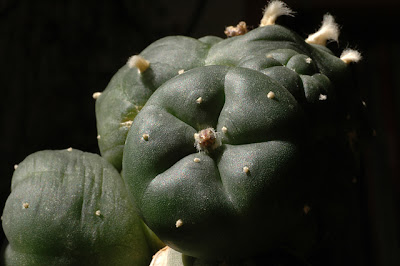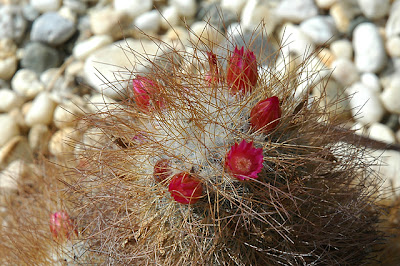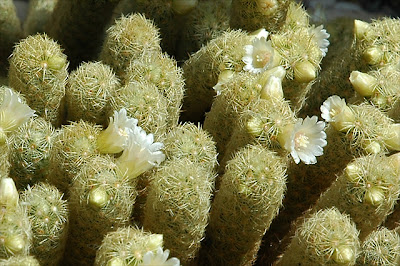Today one of my Lophophora williamsii (SB 854; Starr Co, Tx) plants is celebrating its 3rd anniversary as a scion grafted onto a Trichocereus pachanoi stock. The plant has set 4 offshoots and grown to a width of 7.3 cm (~2.9''), 3 of the offshoots are wider than 4 cm (~1.6'') while the smallest just exceeds 2.5 cm (~1'').
_20070421.jpg)
Grafted Lophophora williamsii (SB 854; Starr Co, Tx)
The plant set 9 flowers last year and has already displayed two flowers this year. The dried fruits resulting from last season’s flowers are clearly visible in the above photo along with the withered remains of the two “fresh” flowers from this week. The photo below was taken a couple of days ago while the flowers were still at their peak.
_20070421.jpg)
Two early Lophophora williamsii flowers
Usually I assist the plant with its self-pollination but this season I will not interfere. I’m doing this to test to which degree the plant will be able to set seed without any help – of course I can’t do anything about the thigmotropic reactions of the stamens or insects taking liberties with the flowers ;-)
A couple of days ago a flower bud also appeared on the largest of the offshoots and it will probably bloom within a week; unfortunately I will not be home to witness it. If all the offshoots begin to flower and the main shoot continues to flower in its usual pace, I’ll soon grow more seeds than I’ll ever need.

Offshoot setting a flower
Since last summer the Trichocereus pachanoi stock has also been allowed to grow an offshoot. Usually I remove these from stock plants in order not to starve the scion, but this one appeared almost at soil level and I decided to let it grow and later graft one of last years Lophophora williamsii (SB 854; Starr Co, Tx) seedlings onto it (these seedlings are the result of self-pollinating the above plant, i.e. technically they are clones of the mother plant). I had planned to do the graft today, but I’ll leave for the Netherlands tomorrow and decided to postpone doing the graft till I’m back.

Trichocereus pachanoi stock with offshoot
I was in doubt whether or not to include the last photo but decided to do it anyway. I’m fascinated by the dreamy image of the flowers backlit by the soft light of the setting sun, filtered through the foliage of a sprawling Bowiea volubilis. My girlfriend finds the picture boring and “too green” – but who is she to trust, she’s not into cacti ;-)

Flowers backlit by the setting sun
For comparison you can check the posts on the same graft written one and two years ago.
Update - April 28, 2007
Fortunately I made it home from the Netherlands in time to experience the pup unfold its first flower. The flower is not as sturdy as those of the main shoot, but what’s to expect from a novice ;-)

Flowering Lophophora williamsii pup
Today I also removed the dried fruits of last season’s flowers and freed the seeds.

9 dried Lophophora williamsii fruits

Close-up of dried Lophophora williamsii fruit
The result of the harvest was approximately 100 seeds.

Home grown Lophophora williamsii seeds
Saturday, April 21, 2007
The power of grafting – 3rd anniversary
Thursday, April 19, 2007
A day at the New York Botanical Garden
During a recent vacation in New York City my girlfriend and I decided to leave the turmoil of the city behind for a day and head for the more tranquil environment of the New York Botanical Garden. I had great expectations for the visit, partly because the garden was established by Nathaniel Lord Britton (of Britton and Rose fame) and partly because of the NYBG Virtual Herbarium, a great information source on the Cactaceae family. As it turned out, the garden’s collection of live cacti is rather sparse; fortunately a handful of flowering Mammillarias saved the day ;-)

Mammillaria bombycina (western central Mexico)

Mammillaria rekoi (Oaxaca, Mexico)

Mammillaria elongata (Hidalgo, Mexico)
Even though the number of cacti plants is limited, the Enid A. Haupt Conservatory is a spectacular place and we spent hours exploring it – also, the orchid show was on during our visit, making it a lot easier to convince “She Who Must Be Obeyed” that we should examine the different plants in detail ;-)

A view of the NYBG cactus house (and a random visitor)

The Enid A. Haupt Conservatory
The Enid A. Haupt Conservatory is the largest Victorian glasshouse in the US and the beautiful structure is in itself worth a visit.
The NYBG also has an outside bed with cold hardy cactus species.
All Time Most Popular Posts
-
Lophophora williamsii (peyote) populations have diminished in large areas of South Texas where peyoteros harvest the cactus for ceremonial ...
-
On various occasions I've been asked what growing media I'm using for my cactus plants. I don't have a set soil mix recipe as su...
-
Below is a list of retailers/nurseries selling cactus seed and plants. I've only listed vendors I've done business with. If you ar...
-
Most cacti are easily grown from seed - and with a little patience and care they can be grown into beautiful plants. Lophophora williamsi...
-
In last month’s post on the troubled Texan peyoteros I referred to Anderson’s article on the peyote situation in Texas. Given the importanc...
-
Yet another slightly off topic and probably not entirely politically correct post, but I couldn’t help noticing the similarity of my monstr...
-
Flowering stand of San Pedro cacti (Trichocereus pachanoi) To me the main draw of the San Pedro cactus ( Trichocereus pachanoi (syn. Ech...
-
In the June 2008 issue of the Cactus & Co magazine Jaroslav Šnicer, Jaroslav Bohata, and Vojtěch Myšák described a new Lophophora spec...
-
There seems to be an increased focus on the alarming Texas peyote situation. A couple of weeks ago the Houston Press published a mournful, i...
-
I spent two weeks working in Delhi, India during January. I had one weekend off and had planned to spend it in Delhi at my own leisure, but ...


















